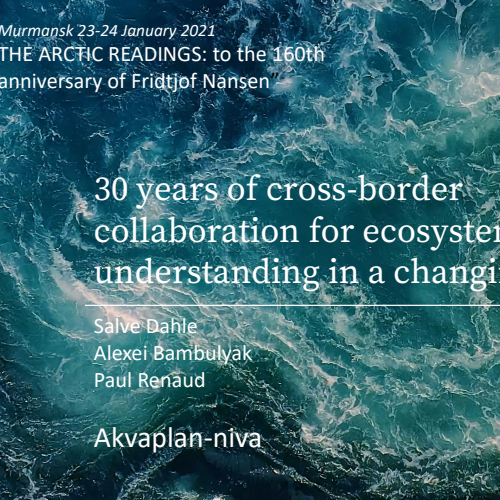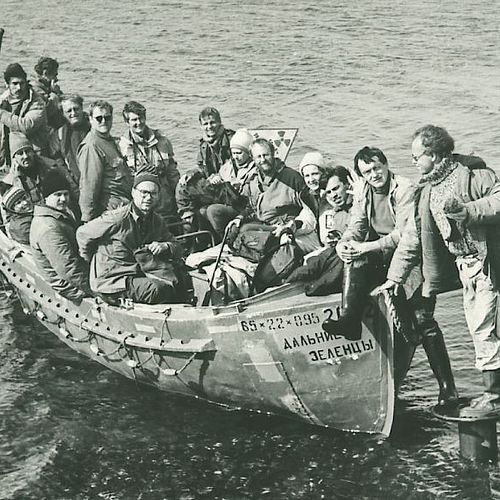25. november 2021 nyhet
Presentation for" The Arctic Readings: to the 160th anniversary of Fridtjof Nansen", Murmansk, 23-24 November 2021 (digital).
By Salve Dahle, Alexei Bambulyak and Paul Renaud, Akvaplan-niva
At the end of the 1980s there was a growing interest in Arctic states for a better understanding of the environmental status in the High North. In 1991 scientists from all Arctic countries met in Tromsø to discuss the structure and content of what was to become the Arctic Council working group the Arctic Monitoring and Assessment Programme (AMAP). The participating states agreed on the main environmental concerns in the Arctic and decided which pollutants should be studied and how.
Akvaplan-niva initiates collaboration
Under this umbrella Akvaplan-niva developed cooperation with scientific institutes in Russia for joint studies of the environment in the European northern seas and coasts. The main partners was institutes belonging to the Russian Academy of Science, and with Murmansk Marine Biological Institute (MMBI) as the most important partner. We have over the years also been working closely with the Arctic and Antarctic Research Institute, Russian Federal Research Institute of Fisheries and Oceanography (PINRO) and Lomonosov Moscow State University and many other institutes.
First joint research expedition
The first joint research expedition with MMBI took place in 1992. The aim of the expedition was to study marine biodiversity and the environmental situation in the Norwegian and Russian Barents Sea, including the coasts of Svalbard, Frans Josef Land, Novaya Zemlya and the islands of Pechora Sea. Applying AMAP guidelines we mapped the concentration of pollutants: heavy metals, oil hydrocarbons, persistent organic pollutants and man-made radioactivity. During the 1990s our joint studies were expanded to include the White Sea and the Kara Sea. All the results were published in Russia by MMBI and jointly the results were published internationally. At that time there was a conception in western countries that the Russian north was very polluted. Our and others' findings made it clear that this was not the case. Some industrial centres were polluted, but generally the environmental situation was better than in most places in Europe. All results were incorporated in AMAP reports to the Arctic Council and the results provided a better understanding of long-range transported pollutants and of knowledge for a better identification of pollutant sources, transport routes and sinks.
Ecosystem understanding
The Norwegian and Barents seas represent highly productive ecosystems, and these seas are home to important commercial fish stocks. At the same time the continental shelf on both sides of the joint Russian-Norwegian marine border contains rich resources of oil and gas. Thus, safeguarding these ecosystems and their productivity is important in both countries at both governmental and industry levels. In 2008 Statoil (now Equinor) supported a 4-year collaboration between Akvaplan-niva and PINRO to study important links in the Barents Sea pelagic ecosystem. In this project we studied the effects of seasonality and interannual variability in ice cover and sea temperature on the plankton base of the ecosystem as well as feeding on this base by capelin and polar cod. Long time-series, up to nearly 60 years for krill, indicated an increased importance of Norwegian Sea plankton species for Barents Sea fish stocks.
Monitoring guidelines for oil and gas exploration
As a result of these scientific efforts Akvaplan-niva took part in further research and in the development of the Norwegian guidelines for monitoring the environment in the vicinity of offshore oil and gas installations. Many countries have later used these guidelines as a model. Research connected to oil and gas activities, and the introduction of these guidelines have formed an important basis for the cooperation between Akvaplan-niva and Russian scientific institutes since the beginning of the 1990s. These research and environmental monitoring projects have been carried out in cooperation with Norwegian and Russian oil and gas companies, as well as Norwegian and Russian authorities.
Ecosystem impacts from the Usinsk oil spill
In 1994 there was a major oil spill close to Usinsk in Komi Republic in the upper part of Pechora River. There was a concern that the oil spill would pollute the mighty Pechora River and impact its rich salmon and whitefish stocks. Pechora River is also a main source of drinking water for many villages along the river and in the Nenets area at the mouth of the river. In cooperation with scientists from Komi and Arkhangelsk, Akvaplan-niva could conclude that no major oil pollution reached the lower parts of the Pechora River. 15 years later Akvaplan-niva scientists and Russian colleagues re-visited the area of the oil spill close to Usinsk. The mission was to study the long-term impact of the oil spill on the freshwater ecosystem and its fish stocks. The work was done in close cooperation with scientists from Komi, Arkhangelsk, Nenets, Karelia, Murmansk and financed by the oil and gas industry. Usinsk area has been an industrial area since the 1930'ies, and our studies concluded that the freshwater system was impacted compared to undisturbed. As an example, it can be mentioned that even if the fish stocks in general seemed to be rich, it was clear that the fish community structure had changed significantly. The share of salmon and whitefishes decreased compared to "grey" fishes, like pike, perch, roach, species with better abilities to resist pollution.
Ongoing collaboration on environmental studies
In the recent decade, Akvaplan-niva has worked with a consortium of Russian partners from St. Petersburg State University, Petrozavodsk State University and VNII Okeangeologia to explore ecologically relevant indicators of petroleum pollution in the Barents coastal region. Results from these studies were communicated to the Joint Russian-Norwegian Environmental Commission. This collaboration also included cross-border exchange of students and teachers in courses on Arctic ecology, biodiversity, and ecotoxicology.
Further, we have also collaborated on multi-stage projects on radioecological studies in cooperation with MMBI along the Kola coast; Polar front studies within the Nansen Legacy project; research projects on Arctic coastal ecosystems and projects on marine litter.
Capacity building for aquaculture development in Russia
In addition to environmental studies, our cooperation with Russian institutes has included aquaculture development as well as the development of communication platforms. Our aquaculture cooperation started with a feasibility study in Northwest Russia in 1993 and was followed by the establishment of a pilot fish-farm in the White Sea in 1996. Since then, we have carried out marine and freshwater aquaculture feasibility evaluations, facility design, capacity building and educational projects in all Russian Barents regions, as well as in other parts of Russia from Kaliningrad in the west to Rostov-on-Don in the south and Vladivostok in the east. For the time being we are cooperating with Russian aquaculture businesses in Murmansk and Karelia on introducing up-to-date solutions and standards for sustainable aquaculture in the North. Developing aquaculture in the Arctic in a sustainable way opens new perspectives for cross-border and inter-sectoral collaboration.
Science-based northern business development
In general, business development in the north on industries like petroleum, shipping and tourism, requires science-based knowledge for balancing economic value creation and environmental protection. These issues are on the agenda in international forums. In 2007, Akvaplan-niva and partners initiated the Arctic Frontiers conference which since has been taking place in Tromsø, Norway annually. In 2011, the conference hosted bilateral Lomonosov-Nansen events devoted to the jubilees of these two famous scientists. This was followed by bilateral seminars in Arkhangelsk. Now, we are honoured to speak at this conference marking 160-years jubilee of Fridtjof Nansen and we very much appreciate the opportunity to present some of our exciting and important experiences from Norwegian-Russian research cooperation.
A pdf version of the full presentation from the conference is downloadable below.


